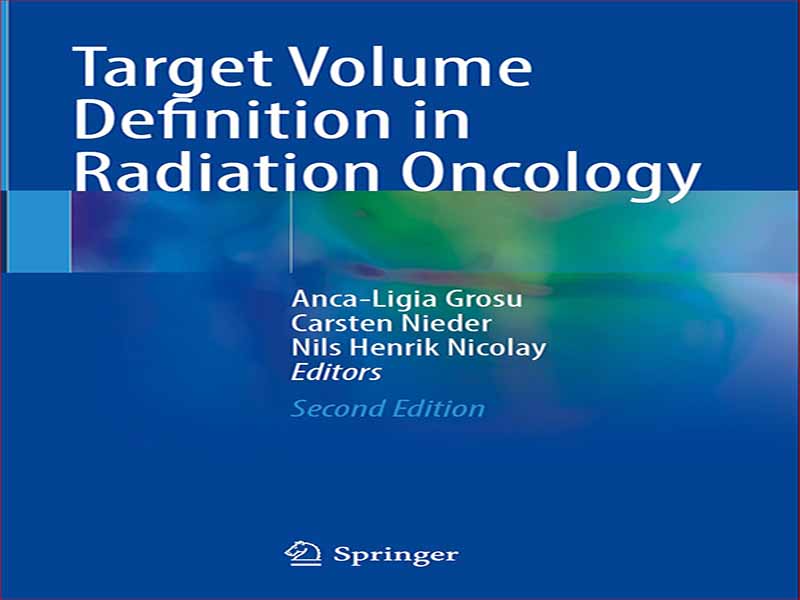- عنوان کتاب: Target Volume Definition in Radiation Oncology
- نویسنده: Anca-Ligia Grosu
- حوزه: انکولوژی
- سال انتشار: 2023
- تعداد صفحه: 462
- زبان اصلی: انگلیسی
- نوع فایل: pdf
- حجم فایل: 34.2 مگابایت
تاریخچه پرتودرمانی برای بیماری های بدخیم تقریباً به قرن بیستم باز می گردد. نه تصویربرداری مقطعی سه بعدی، مانند توموگرافی کامپیوتری یا تصویربرداری تشدید مغناطیسی، و نه تصویربرداری عملکردی، مانند توموگرافی انتشار پوزیترون (PET)، در طول دهههای اول در دسترس نبود. این منجر به رویکردهای برنامه ریزی درمانی شد که اکثر انکولوژیست های پرتوی امروزی کاملاً با آنها ناآشنا هستند. یک مثال خاص که توسعه یک بدخیمی بسیار قابل درمان رادیویی را برجسته می کند، لنفوم هوچکین است. در مقایسه با رادیوتراپی میدان گسترده تاریخی مبتنی بر نشانههای استخوانی که مرزهای میدان را مشخص میکنند، ما شاهد معرفی رادیوتراپی میدان درگیر و گره درگیر، و همچنین الگوریتمهای انتخاب درمان با هدایت یا سازگار با PET بودهایم. توانایی ما برای محاسبه حرکت اندام در حین زایمان، روش تابش اشعه به ریه و مدیاستن را تغییر داده است. به طور همزمان، تکامل فناوری کاربردی با هدایت تصویر و با دقت بالا از توانایی پزشکان برای تعریف دقیق حجم هدف بالینی (CTV) در تعدادی از بیماری ها بهتر عمل کرده است. انکولوژیست های پرتودرمانی باید چندین تصمیم مهم در طول برنامه ریزی و اجرای درمان، یک بیمار در یک زمان اتخاذ کنند. همه چیز با مرحله بندی، بحث چند رشته ای و تعیین حجم شروع می شود، در صورتی که رادیوتراپی اندیکاسیون و توصیه شود. ارائه دقیق درمان تجویز شده به یک CTV که به درستی تعریف نشده است، ارزش محدود یا بی ارزشی خواهد داشت. هوش مصنوعی و یادگیری عمیق شروع به تأثیرگذاری بر فرآیندهای برنامهریزی تشخیصی و درمانی کردهاند و احتمالاً چندین بخش از گردش کار فعلی را تغییر میدهند. هدف این کتاب ارائه انکولوژیست ها و درمانگران پرتودرمانی و همچنین کسانی که در حال آموزش هستند، با مروری مختصر از مهم ترین و به روزترین اطلاعات مربوط به تعریف حجم هدف است. چندین فصل، به عنوان مثال، آنهایی که با لنفوم، سارکوم، و بدخیمی های ستون فقرات/طناب نخاعی سروکار دارند، نه تنها شامل سناریوهای بالینی رایج هستند، بلکه موارد چالش برانگیز و انواع سرطان های نادر را نیز ارائه می دهند. موضوع تغییرپذیری بین ناظران مطرح میشود و در صورت وجود، خواننده با دستورالعملهای اجماع آشنا میشود. موارد اخیر پس از انتشار اولین ویرایش این کتاب درسی در سال 2015 به طور قابل توجهی تکامل یافته است. بنابراین، باید یک ویرایش دوم کاملاً به روز تهیه می شد. ما از اشتیاق و حسن نیت همه نویسندگان فصل در طول تهیه این جلد واقعاً بین المللی و بحث پربار با بسیاری از همکاران بسیار سپاسگزاریم. همه گیری SARS-CoV-2 متاسفانه آماده سازی این نسخه دوم را به تاخیر انداخته است. در نهایت، همه مشارکت کنندگان موفق شدند فصل های به روز خود را ارائه دهند. ما همچنین از حمایت طولانی مدت عالی ناشر قدردانی می کنیم. امیدواریم که خواننده این کتاب را خلاصه ای مفید از دانش روز بداند. تنها تحقیقات مشارکتی ادامهدار، مبنای بهتری برای رژیمهای درمانی قابل تحمل و مؤثر، با بهرهگیری از وعدههای ارائه شده توسط مفاهیم نوظهور پرتودرمانی شخصیسازیشده، فرسایشی و تطبیقی فراهم میکند.
The history of radiation therapy for malignant diseases dates back throughout almost the complete twentieth century. Neither three-dimensional cross-sectional imaging, such as computed tomography or magnetic resonance imaging, nor functional imaging, such as positron-emission tomography (PET), was available during the first decades. This resulted in treatment planning approaches that most of today’s radiation oncologists are completely unfamiliar with. One particular example highlighting the development in a highly radio-curable malignancy is Hodgkin’s lymphoma. Compared to historical extended-field radiotherapy based on bony landmarks defining the field borders, we have witnessed the introduction of involved field and involved node radiotherapy, as well as PET-guided or -adapted treatment selection algorithms. Our ability to account for organ motion during treatment delivery has changed the way of administering radiation to the lung and mediastinum. Simultaneously, evolution of image-guided and high-precision application technology has outperformed clinicians’ ability to precisely define the clinical target volume (CTV) in a number of diseases. Practicing radiation oncologists have to make several important decisions during treatment planning and realization, one patient at a time. It all starts with staging, multidisciplinary discussion, and volume delineation, in case radiotherapy is indicated and recommended. It would be of limited or no value to precisely deliver the prescribed treatment to an incorrectly defined CTV. Artificial intelligence and deep learning are starting to impact the diagnostic and treatment planning processes and are likely to modify several parts of the present workflow.
The purpose of this book is to provide practicing radiation oncologists and therapists, as well as those in training, with a concise overview of the most important and up-to-date information pertaining to target volume definition. Several chapters, e.g., those dealing with lymphoma, sarcoma, and spine/spinal cord malignancies, not only include common clinical scenarios but also present challenging cases and rare cancer types. The issue of interobserver variability is addressed, and when available, the reader is introduced to consensus guidelines. The latter have evolved significantly after publication of the first edition of this textbook in 2015. Therefore, a completely updated second edition had to be prepared.
We are most grateful for the enthusiasm and courtesy all chapter authors showed during preparation of this truly international volume and for the fruitful discussion with many colleagues. The SARS-CoV-2 pandemic has unfortunately delayed the preparation of this second edition. Eventually, all contributors managed to deliver their up-to-date chapters. We also appreciate the excellent long-term support from the publisher. We hope that the reader will find this book to be a useful summary of current knowledge. Only continued cooperative research will provide a better basis for tolerable and efficacious treatment regimens, exploiting the promises put forward by the emerging concepts of personalized, ablative, and adaptive radiation therapy.
این کتاب را میتوانید بصورت رایگان از لینک زیر دانلود نمایید.



































نظرات کاربران